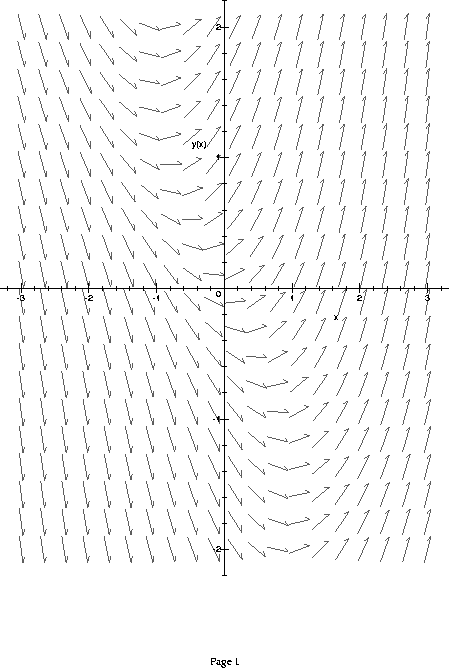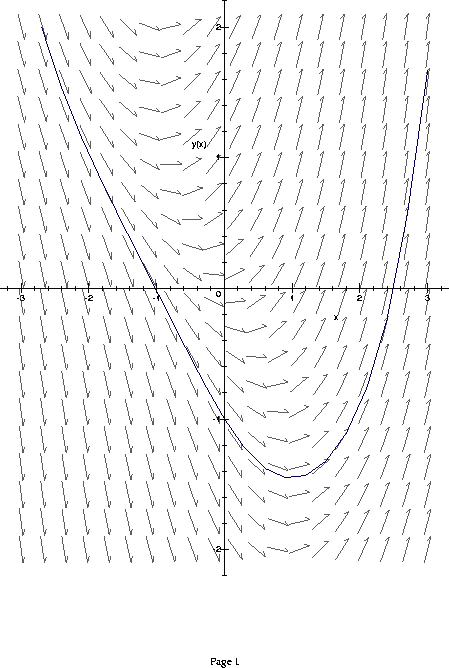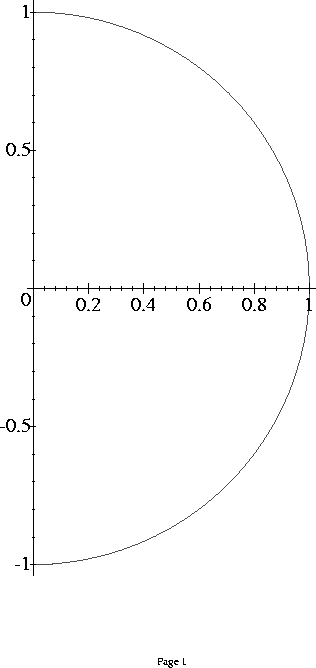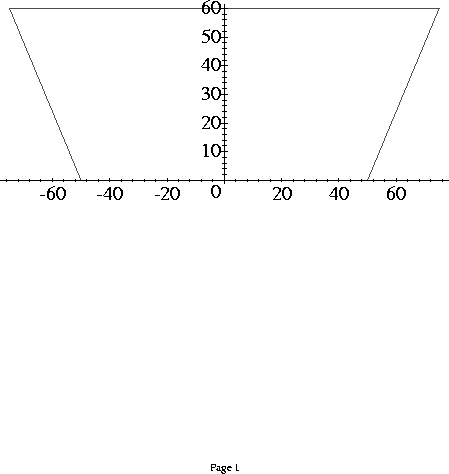MATH 152 Exam II - - Spring 1996
Solutions to Exam 3
Part I - - Multiple Choice - No partial credit - No calculators
1. The series
infinity
-----
\ n - 1
) -----
/ n
-----
n = 2
equals
a) 1 b) 2 c) 3 d) 4 e) does not converge
SOLUTION: The answer is e), because the terms (n-1)/n do not converge
to zero as n --> infinity (the terms converge to one instead).
2. Compute
ln(5 + exp(n))
lim 1/5 --------------
n -> infinity n
a) 0 b) 1/5 c) 1 d) ln(5) e) does not converge
SOLUTION: The answer is b), because as n gets large, ln(5+e^n)
is close to ln(e^n) = n; and so
ln(5 + exp(n))
1/5 --------------
n
approximately equals n/(5n) = 1/5.
3. Let C be the curve y = sin x from
(0,0) to (Pi/2, 1). An integral
which gives the arclength of C is:
1
/
| 2 1/2
a) | (1 + sin(x) ) dx
|
/
0
1/2 Pi
/
b) | 2
| (1 + cos(x)) dx
|
/
0
1
/
|
c) | 1 + cos(x) dx
|
/
0
1/2 Pi
/
d) | 2 1/2
| (1 + cos(x) ) dx
|
/
0
1
/
| 2 1/2
e) | (1 + cos(x) ) dx
|
/
0
SOLUTION: The answer is d). The formula for arclength is
b
/ / 2\1/2
| | dy |
| |1 + ---| dx
| | 2|
/ \ dx /
a
Here, y = cos(x) and so dy/dx = -sin(x). Also a=0 and b = Pi/2.
4. Below is the direction field for a differential equation.
Draw a possible solution for this differential equation whose initial
condition is y(0) = -1.

SOLUTION: Start with the point (0,-1) - the initial condition, and then follow the arrows.
This gives the following graph.

5. Suppose p(t) represents the rabbit population in
Australia in millions where t is in years. Suppose
dp/dt =2p(6-p). For which initial condition is the
rabbit population strictly decreasing for all t > 0?
a) p(0)=8 b) p(0)=6 c) p(0)=4 d) p(0)=2 e) p(0) =0
SOLUTION: The answer is a). Note that responses b) and e) lead
to the constant solution (p(t)= 6 and p(t) =0, respectively). Responses
c) and d) lead to an initial condition where dp/dt > 0 for t=0, which lead
to an increasing p(t). This leaves response a) (where dp/dt = -32 at t=0)
as the only solution.
6. Compute the series
infinity
-----
\ n
) (1/3)
/
-----
n = 2
a) 1/6 b) 1/3 c) 2/3 d) 1 e) does not converge
SOLUTION: The answer is a). This is a geometric series starting
with (1/3)^2. So this sum can be rewritten as
/infinity \
| ----- |
| \ n|
1/9 | ) (1/3) |
| / |
| ----- |
\ n = 0 /
The series in parenthesis is 1/(1-1/3) which is 3/2. So the answer
is (1/9)(3/2) = 1/6, which is response a).
7. Compute the series
infinity
-----
\
) (arctan(n + 1) - arctan(n))
/
-----
n = 1
a) Pi/8 b) Pi/4 c) Pi/2 d) Pi e) does not converge
SOLUTION: The answer is b). This series is a telescoping sum.
The first n terms of this series is
(arctan(2) - arctan(1)) + (arctan(3) - arctan(2)) + (arctan(4) - arctan(3)) + .....
....+ (arctan(n+1) - arctan(n)).
All the terms telescope (cancel) down to arctan(n+1) - arctan(1).
As n --> infinity, the series becomes arctan(infinity) - arctan(1)
which is Pi/2 - Pi/4 = Pi/4, which is response b).
8. Which of the following is a solution of the differential equation
y'' + 4 y = 4?
a) y=1-2 sin(x) b) y=2-2sin(x) c) y= 1+ sin(2x) d) y = e^(2x)/2 e) y = e^(-2x)/2
SOLUTION: The correct answer is c). The general form of the solution
is of the form y= C sin(2x) + D cos(2x) +E, where C, D and E are constants.
the only response of this form is c)
Part II - - Work Out Problems with Partial Credit - Calculators Allowed
10. Let S denote the semicircle of
radius 1 which lies to the right of the y-axis.
Find the x-coordinate of the centroid of S.

SOLUTION: The y-coordinate of the centroid is zero by symmetry.
The integral which represents the x -moment is
1
/
| 2 1/2
| 2 x (1 - x ) dx
|
/
0
This integral can be computed by an easy u-substitution (u=1-x^2)
to get x-moment = 2/3.
The x-coordinate of the centroid is then found by dividing
the x-moment by the area, which is Pi/2. So the
centroid is (4/(3Pi),0).
11. Solve the initial value problem
2
d t
-- x = ----
dt x
with x(0)= -sqrt(2).
SOLUTION: Separate the variables and get x dx = t^2 dt.
Integrate both sides and obtain x^2/2 = t^3/3 + C.
The initial condition x(0)= -sqrt(2) implies that C=1.
So x^2/2 = t^3/3 +1. Solving for x yields
3 1/2
x = - 1/3 (6 t + 18)
Note since x(0) is negative, we must use the negative root of
the square root when solving for x.
12. The Zinn Memorial Dam has the shape of a trapezoid (shown below) which is 60 ft high, 150 ft wide at the top and 100 ft wide at the bottom. The dam maintains a constant water depth of 50 ft. Set up the integral
which gives the force exerted by the water on the dam. Assume the weight density of water is delta = 62.5 lb per cubic foot and let y be the distance measured upward from the bottom of the dam. DO NOT EVALUATE.

SOLUTION: We must integrate the quantity
(density)(depth)(horizontal length)dy
from y=0 to y=60. The horizontal length is 100 +(5/6)y. Note that
this expression is 100 when y=0 (the bottom) and 150 when y=60
(the top). The depth is 60-y. So the integral becomes
> Int(62.5*(60-y)*(100+(5/6)*y),y=0..60);
60
/
|
| 62.5 (60 - y) (100 + 5/6 y) dy
|
/
0
13. Does the following improper integral converge? If yes,
compute it. If not, explain.
1
/
| 1
| ---- dx
| 4/3
/ x
-1
SOLUTION: This integral does NOT converge. Since
the integrand is undefined at x=0, the integral must be split
into an integral from -1 to 0 and an integral from 0 to 1.
Both do not converge. For example, the integral from 0 to 1 is
1 1
/ /
| 1 | 1
| ---- dx = lim | ---- dx
| 4/3 h -> 0 | 4/3
/ x / x
0 h
The antiderivative is
3
- ----
1/3
x
which blows up when x=h --> 0.
14. What is the general solution of the differential equation
/d \
x |-- y(x)| + 2 y(x) = x
\dx /
SOLUTION: First, divide by x to obtain
/d \ y(x)
|-- y(x)| + 2 ---- = 1
\dx / x
The integrating factor is the exponential of the antiderivative of 2/x
or exp(2 ln x) = x^2. Multiplying both sides by x^2 gives
2 /d \ 2
x |-- y(x)| + 2 x y(x) = x
\dx /
or
d 2 2
-- x y(x) = x
dx
Integrating both sides gives x^2 y = x^3/3 + C or
y=x/3 + C x^(-2) as an answer.
15. Suppose x(t) is a solution of the differential equation
/d \
|-- x(t)| + 2 t x = t
\dt /
If x(2) = 1, what is x(0)?
SOLUTION: Here the integrating factor is exp(t^2). Multiplying both
sides by exp(t^2) gives
d 2 2
-- x(t) exp(t ) = t exp(t )
dt
Integrating both sides
2 2
x exp(t ) = 1/2 exp(t ) + C
2
x = 1/2 + C exp(-t )
The initial condition x(2)=1 implies that C = e^4/2.
We get x(0) = 1/2 + C = 1/2 + e^4/2.
16. The point A = (a,0) is moving on the positive x-axis and the point
B=(0,b) is moving on the positive y-axis so that the distance between
A and B
is always 5. Let C be the midpoint of AB . Find parametric equations
for the curve traced out by C using b as the parameter.
SOLUTION: Let a = t. Since the distance between A and B
is 5, we have t^2+b^2=25 or b= sqrt(25 - t^2).
C is the midpoint between (t,0) and (0, b) and so the coordinates of C
are (t/2, (1/2) sqrt(25-t^2) ).
17. What is the length of the curve parameterized by
x=t^2/2 - t y= (4/3) t^(3/2) between t=0 and t=2.
SOLUTION: The arclength formula is
b
/ / 2 2\1/2
| |dx dy |
| |--- + ---| dt
| | 2 2|
/ \dt dt /
a
Here a= 0, b=2 , x= t^2/2-t, dx/dt = t-1, y=(4/3)t^(3/2),
dy/dt = 2t^(1/2).
The quantity under the square root becomes (t-1)^2 +4t = t^2+2t +1 = (t+1)^2.
After taking the square root, the integrand becomes t+1.
So the integral for the length is
2
/
|
| 1 + t dt
|
/
0
which evaluates to 4.




